-
PDF
- Split View
-
Views
-
Cite
Cite
Niketas C. Spero, Yamaira I. Gonzalez, Mark A. Scialdone, David L. Hallahan, Repellency of Hydrogenated Catmint Oil Formulations to Black Flies and Mosquitoes in the Field, Journal of Medical Entomology, Volume 45, Issue 6, 1 November 2008, Pages 1080–1086, https://doi.org/10.1093/jmedent/45.6.1080
Close - Share Icon Share
Abstract
The essential oil of catmint, Nepeta cataria L., was hydrogenated to yield an oil enriched in dihydronepetalactone (DHN) diastereomers, termed. This material was used for the preparation of liquid alcohol-based and lotion formulations. The efficacy of these formulations as repellents was tested after application to human test subjects at two locations in the United States: Maine and Florida. In Maine, data on repellency of the hydrogenated catmint oil formulations toward black flies (Simulium decorum Walker) and mosquitoes (primarily Aedes intrudens Dyar) were obtained. In these tests, protection from black flies was conferred for 6 h or more with all formulations, and both liquid and lotion formulations at 15 wt% active ingredient gave complete protection for 7.5 h. All formulations conferred protection from mosquitoes for >4 h, with the best (15 wt% lotion) giving >8 h of complete protection. In Florida, data on repellency toward a mixed population of mosquitoes indicated that all formulations conferred protection for >4 h, with the 15 wt% lotion giving >6 h complete protection from bites.
Many plant species produce essential oils (aromatic oils) that are used as natural sources of flavor, fragrance, and insect repellent chemicals (Hay and Waterman 1993, Peterson and Coats 2001, Schultz et al. 2004, Krajick 2006). These oils are rich in volatile monoterpenoids, with which repellency has generally been associated (Moore et al. 2006). Within the genus Nepeta, several species produce an essential oil rich in the iridoid class of monoterpenoids (Inouye 1991), more specifically the methylcyclopentanoid nepetalactones (Fig. 1) and derivatives (Regnier et al. 1967a, b, Clark et al. 1997, Schultz et al. 2004). Iridoid monoterpenoids such as nepetalactone have long been known to be repellent to some insect species (Eisner 1964, 1965), and recent studies have extended our knowledge of its repellent potential (Peterson et al. 2002, Peterson and Ems-Wilson 2003, Schultz et al. 2004, Bernier et al. 2005, Chauhan et al. 2005). The related compound dihydronepetalactone (DHN) is also an effective repellent of a number of biting insect species. DHN has been reported as a minor component of the nepetalactone-rich oils of certain Nepeta spp. including N. cataria L. (Regnier et al. 1967b) and may be produced by catalytic hydrogenation of the corresponding nepetalactones in this oil (Regnier et al. 1967b). DHN was described as a constituent of the defensive secretions of certain insects (Cavill and Clark 1967, Cavill 1969, Cavill et al. 1982), and it had been reported that a 7R-configured DHN diastereomer exhibited repellency toward ants (Jefson et al. 1983). DHN was recently shown to be repellent toward blood-seeking insects in laboratory studies. To extend these findings to the field, and test the repellent efficacy of hydrogenated oil of catmint, formulations of this material were prepared. The efficacy of these materials, after application to human subjects under field conditions in the presence of black flies and mosquitoes, is reported.
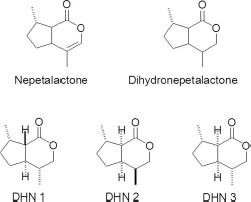
Chemical structures of (7S) nepetalactones and dihydronepetalactones.
Materials and Methods
Test Materials.
Commercially available catmint oil (Botanix, Kent, United Kingdom) was obtained and used to produce the hydrogenated product (abbreviated as HCO). The catmint oil was diluted in an equal weight of ethanol, and after addition of 10 wt% Pd on carbon catalyst (Escat 142; BASF Catalysts, Iselin, NJ), was exposed to H2 at 500 psi with stirring, for 2 h at 25°C and then at 100°C for an additional 2 h. On completion of hydrogenation, the mixture was filtered to remove catalyst, and ethanol was removed by distillation. Gas chromatograph (GC) analysis of this hydrogenated material indicated 69.67 wt% DHN, predominantly DHN2 (60.16 wt%). The remainder consisted of other iridoids (0.09 wt% nepetalactones, 2.34 wt% nepetalic acid, 2.29 wt% puleganic acid) and 25.61 wt% unidentified constituents. The hydrogenated oil was used to prepare formulated lotions and alcohol-based pump sprays, at 7 or 15 wt% Hydrogenated catmint oil at Cosmetech, Fairfield, NJ.
Study Sites.
The tests in Maine were at locations near Lake Nicatous (Hancock County). Three separate tests were carried out, between 6 and 9 June 2006. Black fly repellency tests were carried out on 6 and 7 June 2006. The temperatures (dry bulb) at the test site ranged between 65 and 80 (day 1) and 59 and 65°F (day 2). Relative humidity ranged between 58 and 88%, and the maximum wind speed recorded was 1.0 mph. During the test for mosquito repellency (9 June 2006), the temperature (dry bulb) at this test site ranged between 55 and 63°F, relative humidity was between 79 and 95%, and the maximum wind speed recorded was 0.3 mph. The test in Florida (19 August 2006) was conducted at Pine Island in Collier Seminole State Park (Collier County). The temperature (dry bulb) at this test site ranged between 75 and 91°F, relative humidity was between 62 and 96%, and the maximum wind speed recorded was 0.7 mph.
Field Repellent Tests.
All test subjects gave informed consent, and test protocols were approved by the internal DuPont Human Studies Review Board and an external Institutional Review Board (Essex IRB, Lebanon, NJ). Subject’s shoes were treated with Permanone (0.5% permethrin aerosol) to protect from ticks.
Treatments were applied to delineated 250-cm2 portions of legs (for black flies) or forearms (for mosquitoes) of subjects. The skin above and below the treated areas was protected by elastic bandages. The rest of the subject’s bodies was protected by clothing, gloves, hats, and a head-net. In each test, 10 subjects were treated with the 15 wt% formulations of HCO, with the lotion applied to one limb and the alcohol-based spray to the second. Also in each test, five subjects were treated with the 7 wt% formulations, with each subject again receiving lotion on one limb and alcohol-based spray to the other. Lotions were applied at 2.52 (for the 15 wt% formulation) and 2.56 (7 wt% formulation) mg/cm2. The liquids were applied at 1.61 (15 wt% formulation) and 1.60 mg/cm2 (7 wt% formulation). Active ingredient applications were therefore 1,120 mg/m2 HCO (780 mg/m2 DHN) for 7 wt% formulations and 2,400 mg/m2 HCO (1,672 mg/m2 DHN) for 15 wt% formulations. Subjects remained exposed to insects for 8 h or until repellent breakdown, whichever came first. Repellent breakdown, from which complete protection time (CPT) is derived, occurred when the first confirmed bite (mosquitoes) or landing (black flies) was received. This was defined as the first of two bites/landings occurring within 30 min of each other. A blackfly needed to land and remain on the surface for at least 2 s to be recorded as landing. Landing, rather than bites, was the criterion for black flies because the bite of black flies is painful for an insect of this size and bites usually turn into sores that may last a week or more. For the purpose of calculating an average CPT, 8 h was used when there was no first or confirmed landing/bite on a given subject, in which case the true mean is greater than the calculated average.
Untreated subjects, chosen at random from the available subjects at the start of each day of testing, were used to obtain counts of landings on untreated skin, as well as on the whole body. These subjects were prepared similarly to the treated subjects, but 250 cm2 of bare skin was left untreated and exposed for each count (5 min). Insects were periodically aspirated from untreated subjects into vials for subsequent identification.
Results
Two topical formulations of HCO, a lotion and a liquid pump spray, were prepared, each at two different active ingredient concentrations (7 and 15 wt%), for use in tests in the field in 2006. Preliminary (arm-in-) cage studies indicated that the lotion formulation increased CPT two-fold over alcoholic solutions and alcohol-based pump spray formulations with the same active ingredient concentration (data not shown). Three separate tests were conducted in Maine, two against black flies and a third against mosquitoes, using these materials. A fourth test was conducted in Florida against mosquitoes.
The control counts for landings of mosquitoes on untreated subjects in Maine are presented in Fig. 2. The data showed that, although mosquito activity was highest on the morning of the test, significant numbers of landing mosquitoes were present throughout the 8-h test duration. Identification of mosquitoes collected from control subjects was performed subsequent to the test, and all identifiable mosquitoes were female Aedes intrudens. Figure 3 shows the CPT for each treated subject in this test. The 15 wt% lotion conferred complete protection on every subject for the duration of the test, and other formulations, even at lower concentrations of active ingredient, were highly effective in this test. The lotion formulations outperformed the liquid formulations with equivalent active ingredient concentration, an effect more marked with the lower active concentration (7 wt%) formulations. This supported the data indicating enhanced efficacy of the lotion formulation observed in earlier cage tests. The average CPTs for each formulation are summarized in Table 1.
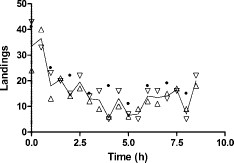
Mosquito landings on untreated control subjects (Maine). Shown are counts of mosquito landings on 250-cm2 untreated skin (triangles) of two subjects (5 min every 30 min), together with counts of landings on the whole body (filled circles) of one untreated subject (1 min every 60 min). The line indicates the average of the counts on exposed skin. Counting was started at 0805 hours.
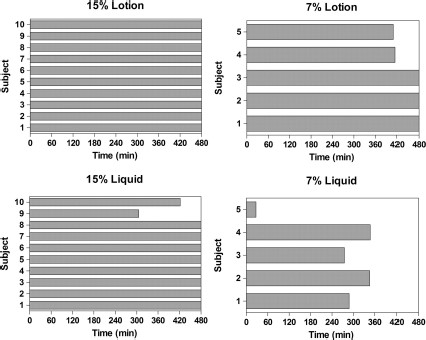
Protection time for each subject for each of four formulations of HCO (Maine field test, mosquitoes).
Mean complete protection time for each HCO formulation tested against mosquitoes in the field (±SE)
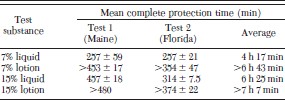
Mean complete protection time for each HCO formulation tested against mosquitoes in the field (±SE)

The control counts for landings of mosquitoes on untreated subjects in Florida are presented in Fig. 4. Significant numbers of landings occurred throughout the duration of the test. The whole body count ranged from 7 to 49 landings per minute, and landings on bare skin of two untreated subjects ranged from 5 to 43 during the 5-min exposure periods over the course of the test. Identification of mosquitoes collected from the control subjects indicated that a number of species were present, with landing frequency varying by genus throughout the day of testing (Fig. 5). The principal species identified were Aedes atlanticus Dyar and Knab, Culiseta melanura Coquillet, Aedes taeniorhynchus Weideman, and Psorophora ferox von Humboldt.
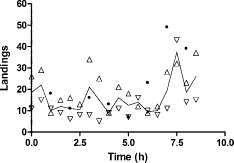
Mosquito landings on untreated control subjects (Florida).Shownare counts of mosquito landings on 250-cm2 untreated skin (triangles) of two subjects (5 min every 30 min), together with counts of landings on the whole body (filled circles) of one untreated subject (1 min every 60 min). The line indicates the average of the counts on exposed skin. Counting was started at 0857 hours.
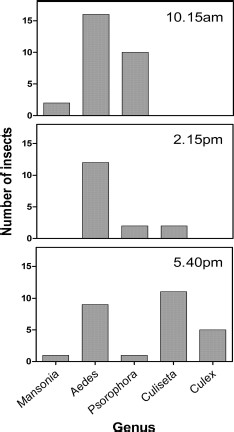
Counts of different genera of mosquitoes collected at different times during the course of the test in Florida.
Figure 6 shows the CPT for each treated subject in this test. All formulations conferred mean complete protection from bites of >4 h, with the 15 wt% lotion formulation providing protection for >6 h (Table 1).
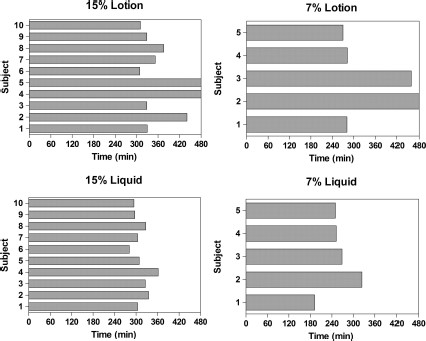
Protection time for each subject for each of four formulations of HCO (Florida field test, mosquitoes).
The formulations provided substantial protection against black flies in tests carried out on 2 sequential days in Maine. Shown in Fig. 7 are the control counts of landings on untreated subjects for these tests, again showing that large numbers of these insects were present throughout the test periods. Identification of flies collected from control subjects was performed subsequent to the test, and this analysis indicated that the species present was Simulium decorum. In Fig. 8, the CPT is shown for each subject on the first of the 2 days of testing. The data indicate that the formulations tested were effective against this nuisance insect species in the field (Table 2). Against black flies, the differential efficacy between lotion and liquid formulations observed with mosquitoes (above) is apparently absent.
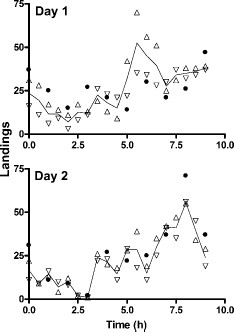
Counts of blackfly landings on 250-cm2 untreated skin (triangles) of two control subjects (5 min every 30 min), together with counts of landings on the whole body (filled circles) of one untreated subject (1 min every 60 min). The line indicates the average of the counts on exposed skin. Counting was started at 1002 hours on day 1 and 0819 hours on day 2.

Protection time for each subject for each of four formulations of HCO (Maine field test, day 1, black flies).
Mean complete protection time for each HCO formulation tested against black flies in the field (±SE)

Mean complete protection time for each HCO formulation tested against black flies in the field (±SE)

Two-factor analysis of variance was conducted to determine how repellent efficacy was affected by formulation type and active ingredient concentration. The outcomes of these analyses are given in Tables 3 and 4. In tests against mosquitoes (Table 3), both active ingredient concentration and formulation contributed very significantly to the variation in the data. Although there was a statistically significant interaction between these two factors, this contributed only 6.13% of the variance. Against blackflies, a different picture emerged, with no significant interaction between active ingredient concentration and formulation type. In tests against this species, only active ingredient concentration contributed significantly to the variation, accounting for 10.56% of the variance.
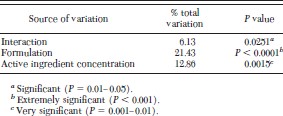



Discussion
In this paper, we report on the repellency, in the form of formulated topical preparations, of catmint oil after catalytic hydrogenation. The particular oil used was enriched in cis,trans-nepetalactone, and hydrogenation yielded a DHN diastereomer mixture consisting predominantly of DHN2.
The complete protection times observed for each formulation of HCO during each field test were obtained (Tables 1 and 2). Overall, the data indicates this material is a highly effective insect repellent against some of the key nuisance and disease vector species of biting insects. Repellency of formulations toward black flies (Simulium decorum) and mosquitoes (primarily Aedes intrudens) was assessed in the field in Maine. In these tests, on average, all formulations conferred protection from black flies for 6 h or more, and both liquid and lotion formulations at 15 wt% active ingredient gave mean complete protection of >7.5 h. These formulations also conferred protection from mosquitoes for >4 h, with the best (15 wt% lotion) giving >8 h complete protection. In a field test in Florida, data on repellency toward a mixed population of mosquitoes indicated that all formulations conferred complete protection for >4 h, with the 15 wt% lotion giving >6 h of complete protection from bites.
Some comparison of these data with repellency evaluations of other insect repellents reported in the literature can be made, with the accepted caveat that such comparisons are often problematic because of differences in climate, species, application rates, criterion for breakdown, etc. Considerations for repellency testing, as well as performance data on existing repellents, have recently been thoroughly reviewed (Debboun et al. 2007). A comparable study of field mosquito repellent performance was carried out (Barnard et al. 2002), where ethanolic solutions of diethyl-m-toluamide (DEET), IR3535, and KBR3023 (Picaridin), together with a proprietary formulation of p-menthane-3,8-diol (PMD), were assessed in the field in Florida. These authors reported mean CPT for 25% DEET as 5.6 h, 25% Picaridin as 5.4 h, 25% IR3535 as 3.0 h, and 40% PMD as 3.8 h. The application rates of these active ingredients in this field test were significantly greater than those used in the study reported here, at 3,845 mg/m2 for the 25% solutions. Even with these higher concentrations and application rates, the values observed for CPT of 25% DEET and Picaridin in these field studies were comparable to those reported here for a 7 wt% ethanolic HCO formulation. CPTs for 25% IR3535 and 40% PMD repellents were inferior. Field evaluations of DEET and a piperidine repellent against mosquitoes and black flies (Debboun et al. 2000) concluded that treatments of 2,500 mg/m2 would have to be reapplied every 5-6 h to confer ≥95% protection against mosquitoes (Ae. communis DeGeer) and black flies (S. venustum Say). These active ingredient application rates are similar to those reported here for the 15 wt% HCO formulations, which conferred complete protection for >7 h. At the lower application rates of the 7 wt% HCO formulations, 6-7 h complete protection was obtained, equivalent or better than that obtained by Debboun et al. with their higher application rates of DEET.
The results presented here indicate strongly that HCO in different topical formulations, offers an effective alternative to existing natural and synthetic insect repellents.
Acknowledgements
The many staff of ICR who assisted with the repellency testing described here are gratefully acknowledged, as are the test subjects. H. Harlan performed the identification of collected insects. B. Kou, J. Fisher, and D. Berg of DuPont Canada (Kingston, Ontario, Canada) kindly carried out the hydrogenation reactions. The cooperation of I. Palefsky and staff at Cosmetech is gratefully acknowledged. The technical assistance of B. D’Achille, W. Bazela, A. Liauw, and T. Ganzke (DuPont CR&D) is gratefully acknowledged, as is the analytical contribution of N. Luu (DuPont CR&D).
Hydrogenated catmint oil has been assigned the INCI name "Hydrogenated Nepeta cataria Oil" and the tradename "Refined Oil of Nepeta cataria" by the Personal Care Products Council.
References Cited



